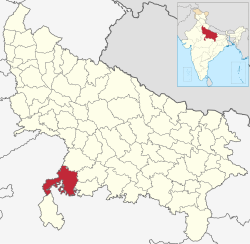Jhansi district | |
|---|---|
 Location of Jhansi district in Uttar Pradesh | |
| Country | |
| State | Uttar Pradesh |
| Division | Jhansi |
| Headquarters | Jhansi |
| Tehsils | 1. Jhansi, 2. Mauranipur, 3. Moth, 4.Tehroli, 5.Garautha |
| Government | |
| • Lok Sabha constituencies | Jhansi |
| Area | |
• Total | 5,024 km2 (1,940 sq mi) |
| Population (2011) | |
• Total | 1,998,603 |
| • Density | 400/km2 (1,000/sq mi) |
| • Urban | 833,484 |
| Demographics | |
| • Literacy | 75.05% |
| • Sex ratio | 890 |
| Time zone | UTC+05:30 (IST) |
| Website | jhansi |
Jhansi district is one of the districts of Uttar Pradesh state in northern India. The city of Jhansi is the district headquarters. The district is bordered on the north by Jalaun District, to the east by Hamirpur and Mahoba districts, to the south by Tikamgarh District of Madhya Pradesh state, to the southwest by Lalitpur District, which is joined to Jhansi District by a narrow corridor, and on the east by the Datia and Bhind districts of Madhya Pradesh. Population 19,98,603 (2011 census). Lalitpur District, which extends into the hill country to the south, was added to Jhansi District in 1891, and made a separate district again in 1974.


